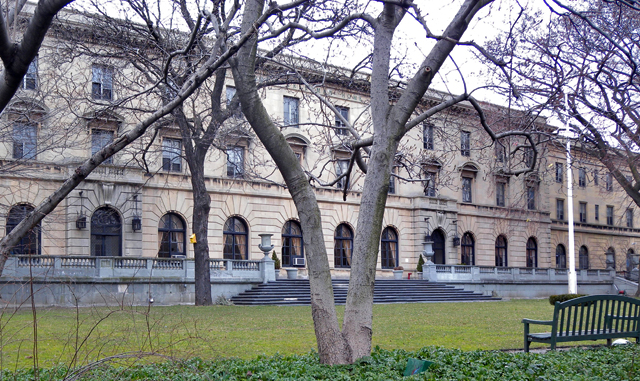By Manon Paulic
The Bronx Journal Staff Writer
Imagine being fabulously wealthy and suddenly losing your riches, right as retirement nears. After years of an aristocratic lifestyle, to find yourself suddenly rubbing elbows with hoi polloi in the almshouse.
Farsighted philanthropist Andrew Freedman imagined such a possibility and dedicated a considerable part of his fortune to saving misfortunate elites from this fate. Freedman, who made a fortune as owner of the New York Giants baseball team, left millions upon his death in 1915 for the construction of an Italian Renaissance retirement abode for penniless millionaires who were desirous of maintaining their upper crust lifestyles.
The result is the historical Andrew Freedman Home on the Grand Concourse in the Bronx, an eccentric and outrageous throwback to an earlier era. The 61,000 square foot, block-long estate between 166th and McClellan streets is stunning with beautiful gardens, wrought-iron doors, and a striking limestone facade.
The Act of Incorporation for the Freedman home in March of 1916 specifies who will be admitted, free of charge. “There shall be no limitation or discrimination other than that the beneficiaries shall be limited to such persons as shall at one time have been in good circumstances.”
Freedman’s vision was to create an upscale “club” where elderly indigent “members,” particularly married couples, would while away their golden years in a “cordial” environment with a well-stocked library, billiards and shuffleboard.
In his will, Freedman left $5 million to have the palatial building constructed and it was completed in 1924. There is a sweeping dining hall and a library with dark wood paneling with many of the original books, including a first edition of Truman Capote’s “In Cold Blood.” One can almost imagine the first residents sitting there, leisurely reading in chairs alongside beautiful wooden tables.
In fact, some staff say that on certain floors, they are convinced there are ghosts.

In its heydey, married couples shared larger living quarters than their single, or widowed, counterparts. Three meals were served a day. There were sitting, pool and card rooms. In the evenings there were social events such as musical programs, cocktail receptions, and outings. Other entertainment included arts and crafts. Medical services were provided for the formerly affluent seniors.
Though the home began as a free option for the nouveau poor, during the 1960s and 1970s operating costs continued to rise. Ultimately residents were asked to pay some rent. The Mid-Bronx Senior Citizens Council eventually purchased the landmark building in 1984. Currently, the non-profit organization provides various social and educational services for residents and senior citizens of the South and Mid-Bronx.
There is keen interest in renovating the Andrew Freedman Home. Suggestions run the gamut — from building a hip hop or children’s museum, to using it as a multi-purpose site for film festivals or a youth hostel, or building condominiums. But no formal decisions have been made yet.


